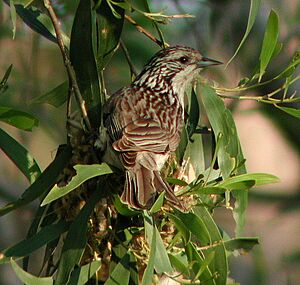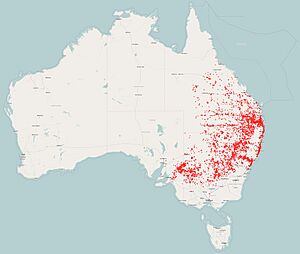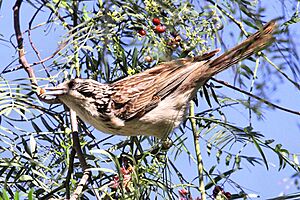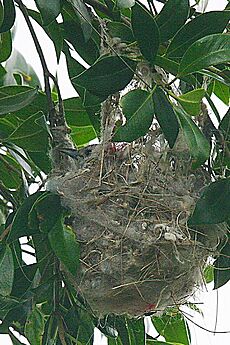Striped honeyeater facts for kids
Quick facts for kids Striped honeyeater |
|
|---|---|
 |
|
| Conservation status | |
| Scientific classification | |
| Genus: |
Plectorhyncha
|
| Species: |
lanceolata
|
 |
|
| The distribution of the striped honeyeater Data from The Atlas of Living Australia |
|
The striped honeyeater (Plectorhyncha lanceolata) is a cool bird from the honeyeater family, called Meliphagidae. You can find it living in Australia. This bird is about 23 centimeters (9 inches) long, which is a medium size for a honeyeater.
Both male and female striped honeyeaters look similar. They are light greyish-brown with dark brown centers on their feathers. This makes them look like they have stripes! These stripes are super clear on their head and the back of their neck.
Even though it's called a honeyeater, this bird mostly eats insects. Its beak is shaped perfectly for catching bugs. When they are not busy raising chicks, they often travel and eat in small groups. But when it's time to nest, they build their homes alone. They usually lay about three eggs in a deep, cup-shaped nest that hangs from tree branches.
The striped honeyeater lives in many places and is quite common. Because of this, experts say it's a bird of "least concern" for conservation. This means it's not in danger of disappearing.
Contents
About the Striped Honeyeater's Name
The striped honeyeater was first described by a British bird expert and artist named John Gould. He wrote about it in a book in 1838. This bird is part of the honeyeater family, Meliphagidae. It's the only bird in its special group, called Plectorhyncha.
The name Plectorhyncha comes from old Greek words. Plēktron means 'spear-point' and rhynkhos means 'bill'. This name describes its thin, pointed beak. The second part of its name, lanceolata, is Latin for 'lance-shaped'. This refers to the long, pointed feathers on its throat and chest. Sometimes, people also call it the lanceolated honeyeater.
Honeyeaters are related to other bird families like the pardalotes and Australian fairy-wrens. They all belong to a bigger bird group called Meliphagoidea.
What the Striped Honeyeater Looks Like
The striped honeyeater is a medium-sized bird. It is usually between 22 and 25 centimeters (8.7 to 9.8 inches) long. Its wings can spread out from 28 to 36 centimeters (11 to 14 inches) wide. On average, it weighs about 40 grams (1.4 ounces).
Its upper body is light greyish-brown. The feathers have dark brown centers, which makes them look striped. These stripes are very clear on its head and neck. They are less clear on its back and almost gone on its tail feathers. Its belly is whitish with light streaks. The feathers on its upper chest and throat are long and pointed, making its head look a bit spiky.
The wings and tail are both medium length with rounded tips. Its beak is short, sharp, and pointed. It's dark blue-grey, becoming grey-black at the tip. The skin around its eyes is dark brown, and its eyes are dark black-brown. Its legs and feet are blue-grey with black claws.
Male and female striped honeyeaters look very much alike. Young birds are a bit browner than adults. They have buff or brown edges on their wing and back feathers. Young birds look less streaky than adults. They get their adult feathers when they are about one year old. Their feathers don't change much during different seasons.
The striped honeyeater's song sounds like "chirp, chirp, cherry, cherry." When they want to get another bird's attention, they make a sharp "chewee" sound. Their alarm call is a loud, whistling note.
Where Striped Honeyeaters Live
This bird mostly lives in eastern Australia, especially inland. It likes dry, open forests with trees like mallee and mulga. You can also find them in heathland and mangroves near the coast.
In the past, people were surprised to see them near the coast. But now, they are found all along the eastern coast from central Queensland down to New South Wales. They can also be found inland, reaching into South Australia. Sometimes, if the weather or habitat changes, small groups might show up in new places.
Striped honeyeaters live in many different types of places. These include woodlands near rivers with trees like river red gum. They also like mallee woodlands, especially where there are thick bushes. You can find them in pine forests on sand ridges and in dry scrubland with acacia trees.
Near the coast, they live in swamp forests with paperbark trees. They also live in places where people live, like caravan parks, gardens, farms, and fruit orchards.
Striped Honeyeater Behaviour
Feeding Habits
Even though it's called a honeyeater, this bird mainly eats insects. It also eats seeds and fruits, and sometimes nectar from flowers. Its beak is short, straight, and sharply pointed. This shape is perfect for poking into cracks to find insects, rather than reaching deep into flowers for nectar. But it does have the special brush-like tongue of a honeyeater, which helps it sip nectar from shallow flowers like those on eucalypt trees.
They usually feed high up in trees, among the leaves. Most of their food comes from leaves, but they also find food on bark, flowers, and fruit. They often pick insects off leaves and dead branches. They also probe under loose bark and in cracks. Sometimes, they even hang upside-down to get insects!
Social Life
Striped honeyeaters are often seen alone or in pairs. Sometimes, you might see them in small groups. When they are not breeding, they might feed together in loose, moving groups. They also drink water with other birds.
They are quite social. They might perch close to each other and even preen (clean their feathers) for each other. When they are in groups, they might chase each other, call out, and scold. Non-breeding striped honeyeaters are noisy. They call while eating and resting, but not often when flying. They have been seen raising their wings and calling, and sometimes they sing duets.
Striped honeyeaters protect their nests by diving at people or animals who get too close. They also sing from high spots. However, they don't seem to protect a large area around their nest like some birds do. They often feed near other honeyeater species, and they don't seem to fight with them.
Reproduction and Life Cycle
Striped honeyeaters breed all over the areas where they live. Usually, a male and female pair up. Both parents help build the nest, sit on the eggs (incubate), and feed the young birds. Sometimes, a third adult bird might help feed the baby birds. They build their nests alone, and pairs might use the same or nearby trees for nesting for a few years.
The breeding season is usually from August to January, but it can change depending on the local weather. They often build their nests in tall bushes or low trees with drooping leaves. Trees like casuarina, melaleuca, and acacia are popular choices. Sometimes, the nest is near or hanging over water. The nest is usually built at the end of a drooping branch, hanging from twigs or leaves. Striped honeyeaters often nest close to where a butcherbird is nesting.
Their nest is deep and shaped like a cup or a bag. It has thick walls, and the opening's edge turns slightly inward. They make the nest from thin, dry grass and cover it with plant fluff, feathers, or wool. This covering often hides the grass frame. They line the inside with spider webs, hair, wool, or small roots. Sometimes, they even use flowers or tissue paper! Striped honeyeaters often reuse materials from old nests.
Their eggs are oval-shaped, about 2.4 centimeters (0.94 inches) long and 1.7 centimeters (0.67 inches) wide. They are a dull white color and have reddish-brown spots all over, especially at the wider end. The striped honeyeater usually lays three eggs, one every 24 hours. Both parents take turns sitting on the eggs for about 16 or 17 days. Each parent sits for about 20 minutes at a time. The young birds leave the nest (fledge) after about 16 days.
Sometimes, the nests of striped honeyeaters are "parasitized" by another bird called the pallid cuckoo. This means the cuckoo lays its eggs in the honeyeater's nest, and the honeyeater ends up raising the cuckoo's chicks.
Conservation Status
The striped honeyeater is found in many places and its population is stable. Because of this, the IUCN (International Union for Conservation of Nature) says it is a bird of "least concern." This means it is not currently in danger of becoming extinct.





